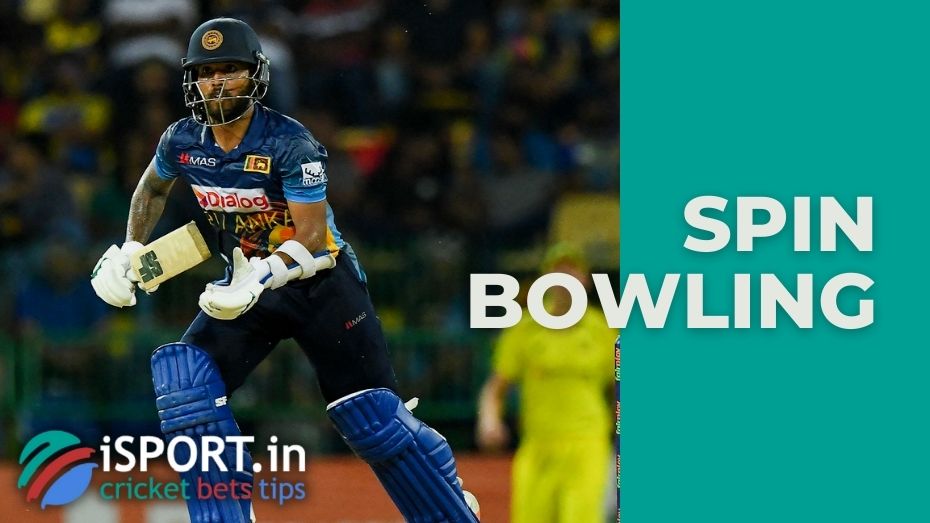Spin bowling

Spin bowling is a method that is widely used in the sport of cricket mostly by slow bowlers, who are also referred to as spinners or spin bowlers. After making contact with the pitch, the ball will undergo an unpredictable shift in trajectory, which is referred to as the rebound. This occurs when the serve is executed correctly.
Fundamentals and Purpose of Spin Bowling
Spin bowling’s primary objective is to make the batter make a positional error. So, the batter either gets out or makes a spade, or he misses his chance to hit the ball into an unbatted area of the field.
Every one of the four major spin bowling variants has its own unique set of rules and regulations.
| A kind of Spin bowling | The hand on the serve | Sets the rotation | The direction of the serve | Representatives of the style |
| Off-spin | Right
|
Finger | From left to right | Jim Laker, Muttiah Muralitharan, Saqlain Mushtaq, Harbhajan Singh, Ravichandran Ashwin |
| Left-arm orthodox spin | Left | Finger | From right to left | Phil Tufnell, Ravindra Jadeja, Daniel Vettori, Rangana Herath, Shakib al-hAsan, Derek Underwood |
| Leg spin | Right | Wrist | From right to left | Abdul Qadir, Anil Kumble, Shane Warne, Mushtaq Ahmed, Shahid Afridi |
| Left-arm unorthodox spin | Left | Wrist | From left to right | Kuldeep Yadav, Brad Hogg, Paul Adams, Chuck Fleetwood-Smith |
Technique, Strategy, and Ball Behavior
Depending on the type of spin bowling that the offensive player likes, he has the option of using either the so-called finger spin, in which the direction of the ball is regulated by the fingers, or the wrist spin, in which the trajectory of the serve is decided by the wrist. His primary responsibility is to spin the ball horizontally, perpendicular to the pitch. The Magnus effect does not preclude the possibility of the ball deviating from its primary trajectory even before it makes contact with the surface of the ground. This occurrence is referred to as drift, and when combined with the rotation of the projectile, it can sometimes make the work of the batsman more difficult.
It is important to note that, in contrast to fast bowlers, who like playing with a brand-new ball, spin bowlers typically choose to use worn-out shells because they provide them the opportunity to attain higher precision on the pitch. Additionally, they are more effective not at the beginning of the match but rather in the later phases of the game, when the pitch condition gradually changes and even a well-treated area begins to crack and crumble. This allows to enhance the angle of deflection of the projectile after it has rebounded off the ball.
There is a greater frequency of spin bowlers performing in test matches as opposed to the limited overs format. Nevertheless, their usage increased with the introduction of Twenty20, particularly in circumstances when the pitch and weather conditions are conducive to slow bowling. It should also be remembered that spin bowling is an effective yet risky strategy when facing batters used to quick bowlers. They typically employ serve speed to set up fast runs, so when they hit spin bowlers, they have to work more to get the same outcomes.
Ball Variations, Evaluation, and Regional Popularity
It is worth clarifying that depending on how exactly the spin bowler spins the ball, the pitch may change its name:
- Topspinner – the ball spins towards the batsman, after which it “dives”, making a rebound;
- Doosra/googly – the ball spins in the opposite direction;
- Slider – the ball is twisted in the direction of the batsman with simultaneous deflection of the seam;
- Arm ball – the seam is positioned strictly vertically, which enhances the effect of rotation;
- Flipper – the ball “snaps” out of the fingers with a back-spin;
- Undercutter – the ball rotates horizontally without changing the angle (that is, it goes into drift).
Furthermore, there are several factors that pundits and professionals use to evaluate the levels of talent possessed by spin bowlers. Accurately:
- Batsmen frequently make mistakes because the ball doesn’t have enough time to bounce, depending on whether the spin bowler tries to make it fly normally or “hang” in the air.
- The angle of the ball’s ricochet after it has bounced is higher when the ball is moving at a slower speed. Additionally, in this case, we consider both the direction of the projectile and the number of rotations it undergoes.
- The higher it is, the better, because a batsman has a harder time getting a good catch when the ball bounces to an awkward height, and a slider sends a projectile that can demolish the wicket before it hits the batter.
- One of two things can happen: either the batsman will create a spade unknowingly or the wicket will be left exposed if the ball hits the pitch at an awkward distance for him.
- As a consequence of the verified drift, the projectile’s speed is drastically reduced, making the batsman anxious and leading to poor position selection.
This is interesting: spin bowling is more often used by players from South Asia. The first and most obvious reason is the climate: in conditions of heat and high humidity, you have to save energy, so fast bowling is less popular in India than, for example, in Australia. Secondly, local grounds are not very dense and firm and are quickly covered with cracks, making it easier for spin bowlers who skillfully use irregularities to grip the ball with the pitch better.
